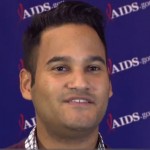Harnessing the Potential of Social Media in HIV Prevention- Voices from AIDS 2014
Earlier this week, our HIV.gov team blogged about the lessons we've learned in the use of online video in Melbourne, Australia, I had the opportunity to attend the session “Harnessing the Potential of Social Media in Global HIV Prevention, Education and Community Building,” which highlighted the importance of planning and evaluation in the effective use of new media and technology.
After the session, I talked with one of the presenters, Ariel Cerrud, the Youth Activist Network Coordinator at Advocates for YouthExit Disclaimer, to get his perspective on evaluation and planning. Ariel emphasized the importance of looking beyond the “likes” and “shares” you receive on your new media channels to examining the real outcomes of your social media work. In other words, looking to see if people took action as a result of your messages. For his organization, this is done by seeing how many people signed a particular petition or contacted their legislator. Those of us working in HIV prevention, care and treatment may look at other indicators such as how many people contacted our agency, made an appointment, took an HIV test, connected to care, or reported adhering to their medication. By thinking beyond likes, shares, and followers, we can start to understand the true impact of our social media efforts.

To learn more, please watch our conversationExit Disclaimer with Ariel above.
Other session presenters included Felix Scholz, from RedAwareExit Disclaimer in Australia, and Laurindo Garcia, from B-Change.orgExit Disclaimer in the Philippines. For a full description of the session and links to the presenters’ PowerPoint presentations, please visit the AIDS 2014 session pageExit Disclaimer. In addition, go to HIV.gov’s new media resources. For more coverage from the conference visit AIDS 2014.